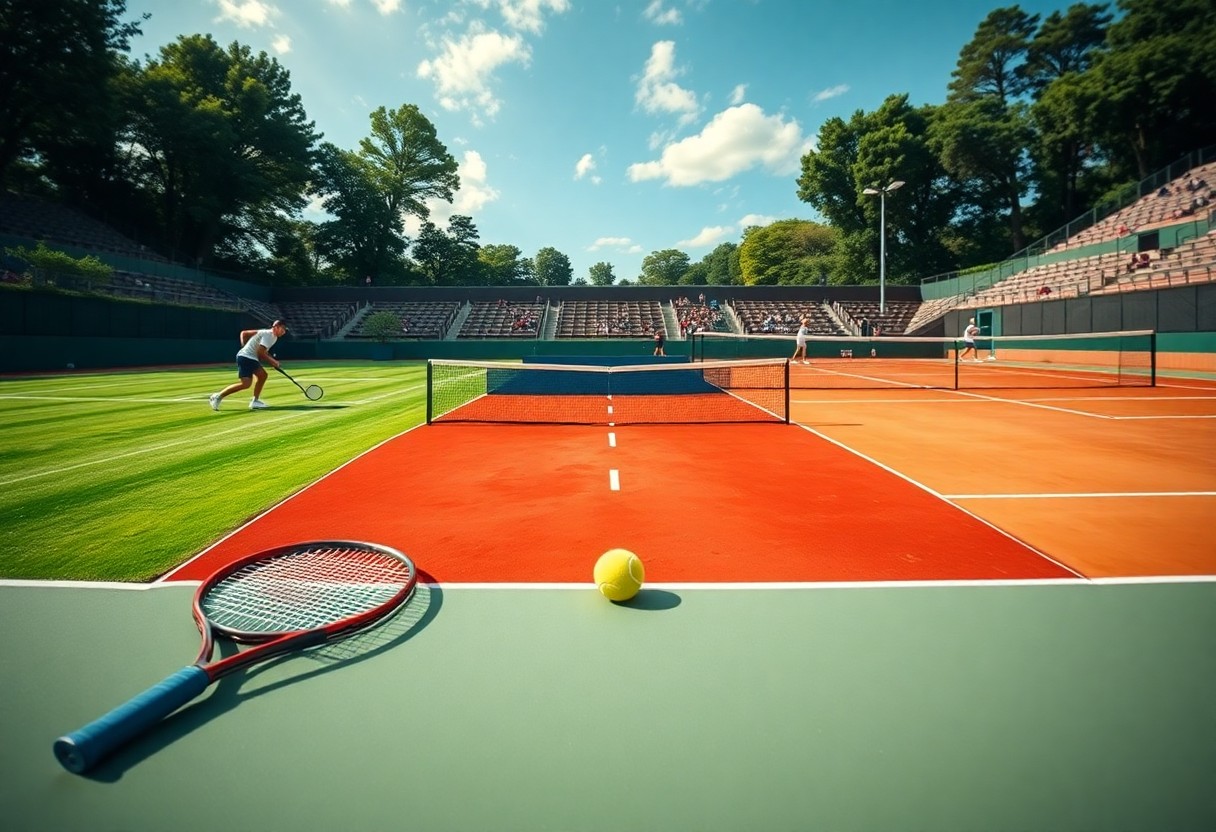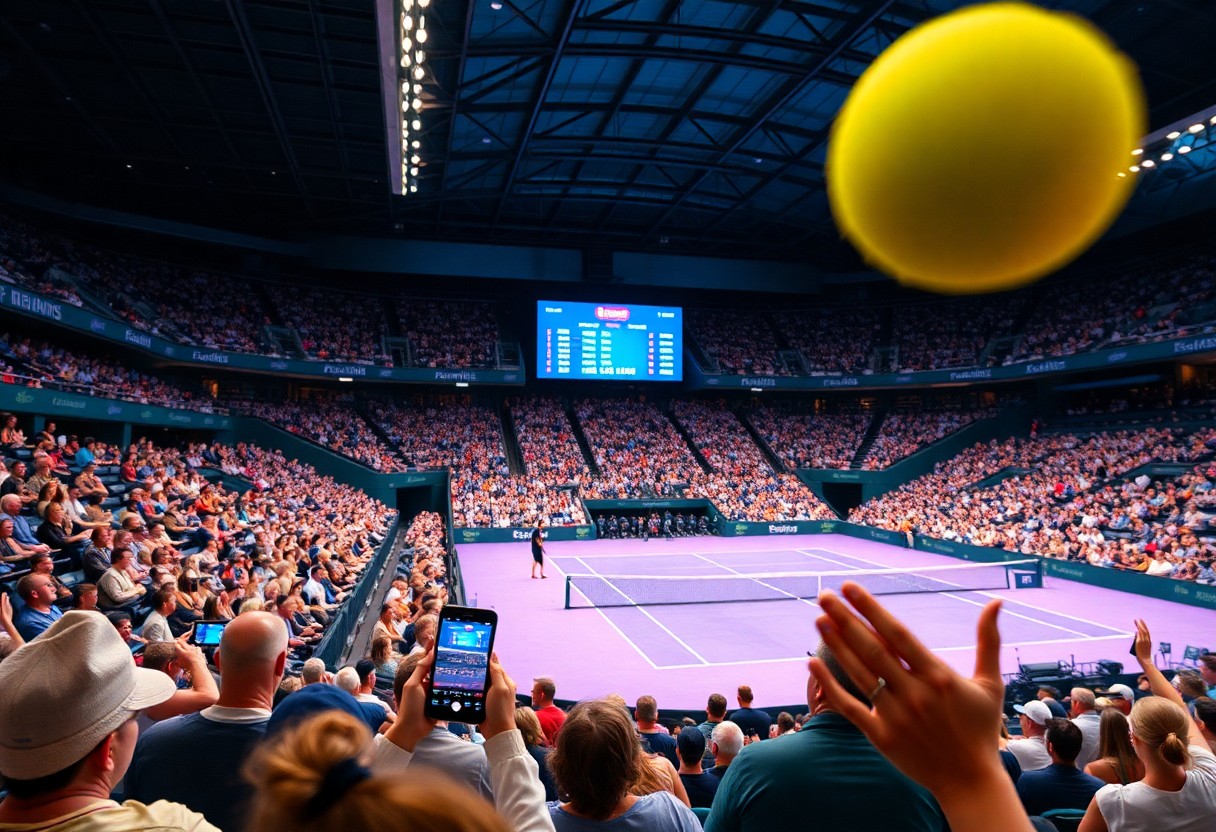Just understanding the differences in tennis court surfaces can significantly enhance your betting strategy. Each surface—grass, clay, and hard courts—presents unique playing conditions and player performances. Grass courts favor servers and agile players, while clay courts benefit those with strong baseline skills and endurance. Hard courts strike a balance, affecting game style and outcomes. By recognizing these factors, bettors can make more informed and profitable choices.
Understanding Tennis Court Surfaces
The playing surface of a tennis court significantly affects game dynamics, influencing player performance, match outcomes, and betting strategies. Each type of court—grass, clay, and hard—presents unique characteristics that favor certain playing styles, skill levels, and conditions, allowing bettors to make informed decisions based on these factors.
Grass Courts
Grass courts are known for their fast playing surface, leading to quick rallies and low bounce. This surface rewards players with strong serves and aggressive net play, making it a preferred choice for serve-and-volley specialists like Roger Federer. The prestigious Wimbledon tournament is the most notable event played on grass, highlighting its unique challenges and advantages.
Clay Courts
Clay courts are characterized by a slower surface and higher bounce, affecting ball speed and spin. Players often adapt by employing strategic baseline play and patience, with top clay court specialists demonstrating endurance and tactical finesse. Events like the French Open showcase the endurance required to dominate on this surface.
Unique to clay is the transition it demands from players. Matches can become longer, as the surface allows for extended rallies, which favors those who excel in physical conditioning and strategic shot placement. Players like Rafael Nadal have reigned supreme on this surface, showcasing how clay molds playing styles that balance aggression with patience.
Hard Courts
Hard courts provide a balanced blend of speed and durability, offering consistent bounce that suits a diverse range of playing styles. This versatility allows for both power hitters and strategic players to thrive, as seen during tournaments such as the US Open and Australian Open. Hard courts are favored by many professionals as they offer a uniform playing experience throughout the year.
Players need to adjust their strategies on hard courts based on surface conditions. Unlike grass or clay, the surface can also vary between parket and asphalt materials, impacting speed and wear. Historically, stars like Serena Williams and Novak Djokovic have excelled on hard courts, each showcasing how adaptability and skill can lead to success across different events.
Impact of Surface Types on Player Performance
Different surface types significantly affect player performance, influencing speed, bounce, and overall play style. Players who excel on grass courts benefit from the fast surface that favors serve-and-volley tactics, while clay courts reward baseline players with longer rallies due to slower speeds. Hard courts provide a balanced platform, accommodating various styles. Overall, surface impacts dictate match outcomes and betting opportunities.
| Surface Type | Performance Impact |
|---|---|
| Grass | Fast pace, low bounce |
| Clay | Slow pace, high bounce |
| Hard | Balanced pace and bounce |
| Grass | Favors serve-and-volley |
| Clay | Favors defensive baseline play |
Player Styles and Preferences
Player style significantly influences performance on different surfaces. For example, serve-and-volley players thrive on grass, while counter-punchers find success on clay. This preference impacts betting strategies, as understanding a player’s strengths helps predict match outcomes based on the chosen surface.
Historical Success Rates
Examining historical performance yields insights into player effectiveness across surfaces. Certain players, like Roger Federer on grass, have consistently dominated, while others excel on clay, such as Rafael Nadal. These historic success rates offer valuable information for bettors, indicating potential match winners based on surface type.
Analyzing historical data reveals patterns in player performance across surfaces, supporting informed betting decisions. For example, Nadal’s staggering 14 French Open titles underscore his dominance on clay, which contrasts sharply with Federer’s superior grass court achievements. This surface-specific success can be quantified in match win percentages, offering bettors a strategic edge when evaluating potential matchups.
Betting Strategies for Different Surfaces
Successful betting on tennis requires adapting strategies to different surfaces. Grass favors serve-and-volley players, making them potential favorites, while clay rewards baseline players with endurance and spin. Hard courts offer a balanced dynamic, showcasing both types. Analyzing a player’s track record on each surface can reveal hidden betting value, enhancing potential returns.
Analyzing Surface-Specific Trends
Understanding surface-specific trends is important for making informed bets. Historical data shows that players often excel on particular surfaces; for instance, Rafael Nadal dominates clay with a staggering win rate. Examining head-to-head matchups can expose these vulnerabilities or advantages, allowing bettors to wager strategically based on players’ past performances.
Adjusting Odds and Predictions
Adjusting odds based on surface type can refine betting accuracy. Oddsmakers account for a player’s performance on specific courts, but disparities exist. For example, a hard-court expert facing a clay specialist may lead to inaccurate odds if the latter is underestimated on faster surfaces. Bettors who recognize these shifts can capitalize on mispriced bets.
Evaluating odds requires a clear understanding of not just player statistics but also contextual factors, such as recent form and weather conditions. A player with a strong record on grass who recently performed poorly can still be a strong contender if matched against someone unaccustomed to the surface. Monitoring changes in betting lines following player announcements, injuries, or weather can provide additional opportunities to exploit shifting odds. Studying these patterns enables more precise predictions and maximizes potential returns on wagers.
Popular Tournaments by Surface Type
Each tennis surface hosts its own iconic tournaments, shaping player strategies and attracting diverse audiences. These tournaments offer unique betting opportunities and insights into player adaptability. Understanding the key events on grass, clay, and hard courts enhances wagering efforts and provides bettors with valuable context.
Grand Slams and Their Surfaces
The four Grand Slam tournaments highlight the diverse conditions encountered on different surfaces. Wimbledon on grass emphasizes serve-and-volley tactics, while the French Open on clay requires exceptional endurance and tactical prowess. The Australian Open and US Open, both held on hard courts, blend elements from both grass and clay, making them unpredictable.
Other Notable Tournaments
Beyond the Grand Slams, several prominent events attract attention for their surface alignment and competitive fields. Tournaments such as the Rome Masters on clay and the Miami Open on hard courts play pivotal roles in shaping player rankings and betting trends.
Many notable tournaments increase visibility for specific surfaces and player performances. For instance, the Monte Carlo Masters, held on clay, is pivotal for players aiming to refine their skills ahead of the French Open, often showcasing a clash between top-ranked clay specialists. The Western & Southern Open, a hard court event in Cincinnati, serves as a significant warm-up just before the US Open, with results that can indicate player form and likely outcomes in the Grand Slam. This insight can greatly inform betting strategies and player analysis.
Risk Factors in Tennis Betting
- Surface Types
- Weather Conditions
- Injury Reports
- Player Form
Assume that understanding these risk factors is imperative for making educated betting choices. Factors such as surface type, player performance, and external conditions can significantly influence match outcomes and betting odds.
Surface and Weather Conditions
Environmental elements can dramatically affect a match’s outcome. Grass courts may become slippery after rain, while clay surfaces become slower, hindering powerful serves. Extreme heat can impact player stamina and performance levels. Always analyze current weather conditions alongside the court type to gauge potential effects on the match.
Injury Reports and Player Fitness
Keeping updated on injury reports is imperative in tennis betting. With players often sidelined due to injuries or struggling with fitness, their on-court performance can suffer drastically, impacting betting odds. Evaluating the extent of injuries and their potential to affect play is key in determining a player’s likelihood of winning.
Injuries can vary from minor strains to serious conditions, affecting both player mobility and strategy. For instance, a top seed dealing with a knee issue might be cautious in their movements, leading to an unexpected loss against an underdog. Analyzing past injury records, recovery rates, and a player’s ability to compete following a physical setback can offer insights that are invaluable when placing bets.
To wrap up
Now that we’ve explored the impact of surface types like grass, clay, and hard courts on tennis betting, it’s clear that understanding these nuances can significantly influence betting strategies. Each surface offers distinct characteristics that affect player performance and match outcomes. By analyzing players’ historical data on specific surfaces, bettors can make informed decisions that enhance their chances of success. Knowledge of these surface dynamics is necessary for developing a robust betting approach in the ever-evolving landscape of tennis.
FAQ
Q: How do different court surfaces affect player performance in tennis betting?
A: Player performance can vary significantly across different surfaces. Grass courts favor players with strong serve-and-volley skills, while clay courts benefit those with consistent baseline play and patience. Hard courts provide a balance, favoring aggressive play. Understanding which players excel on specific surfaces can influence betting decisions.
Q: What impact does surface type have on match outcomes in professional tennis?
A: Surface type can heavily influence match outcomes. Players with favorable records on a specific surface can outperform opponents who struggle with that particular type. Surface analysis can aid bettors in predicting match results, as players often have distinctive strengths and weaknesses related to the court they compete on.
Q: Are there statistical trends associated with different tennis surfaces for betting purposes?
A: Yes, statistical trends indicate that certain players dominate on specific surfaces. Bettors should look at head-to-head records, surface win percentages, and previous tournament outcomes to identify patterns. Analyzing these trends can help in making informed betting choices based on surface preferences.




